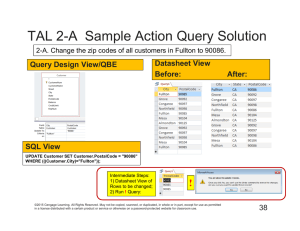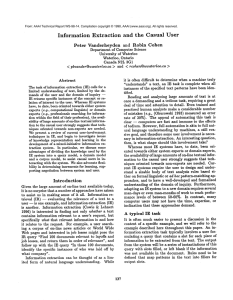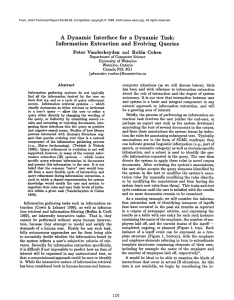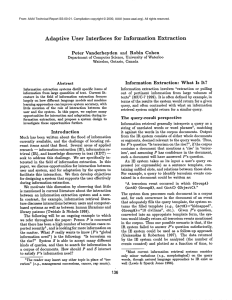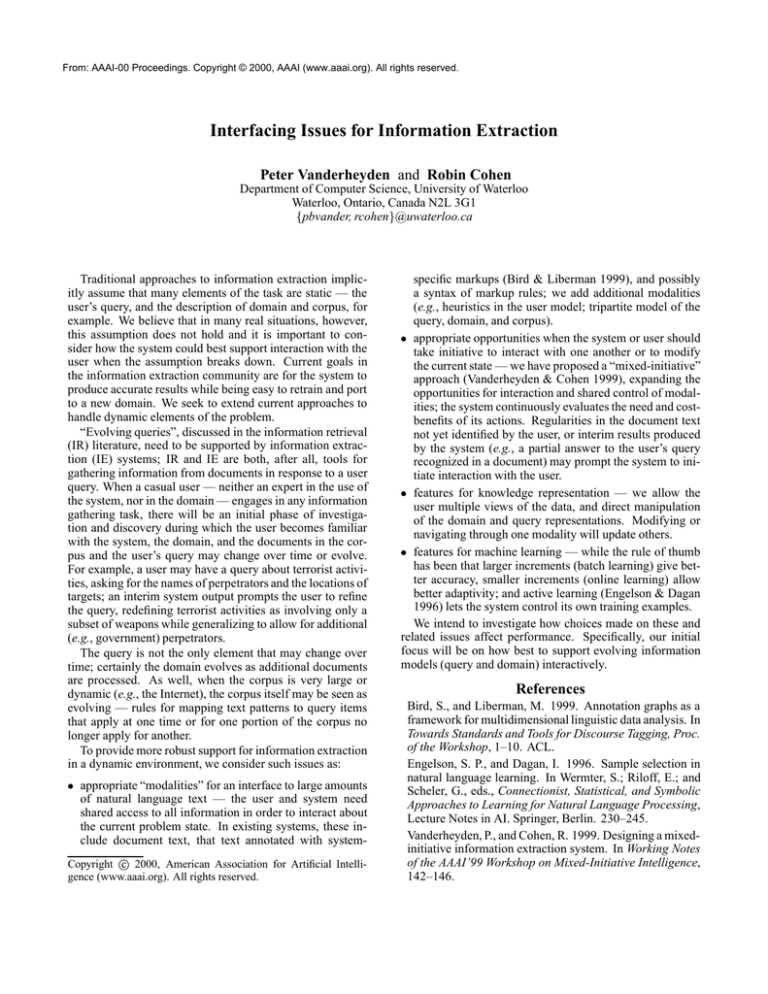
From: AAAI-00 Proceedings. Copyright © 2000, AAAI (www.aaai.org). All rights reserved.
Interfacing Issues for Information Extraction
Peter Vanderheyden and Robin Cohen
Department of Computer Science, University of Waterloo
Waterloo, Ontario, Canada N2L 3G1
fpbvander, rcoheng@uwaterloo.ca
Traditional approaches to information extraction implicitly assume that many elements of the task are static — the
user’s query, and the description of domain and corpus, for
example. We believe that in many real situations, however,
this assumption does not hold and it is important to consider how the system could best support interaction with the
user when the assumption breaks down. Current goals in
the information extraction community are for the system to
produce accurate results while being easy to retrain and port
to a new domain. We seek to extend current approaches to
handle dynamic elements of the problem.
“Evolving queries”, discussed in the information retrieval
(IR) literature, need to be supported by information extraction (IE) systems; IR and IE are both, after all, tools for
gathering information from documents in response to a user
query. When a casual user — neither an expert in the use of
the system, nor in the domain — engages in any information
gathering task, there will be an initial phase of investigation and discovery during which the user becomes familiar
with the system, the domain, and the documents in the corpus and the user’s query may change over time or evolve.
For example, a user may have a query about terrorist activities, asking for the names of perpetrators and the locations of
targets; an interim system output prompts the user to refine
the query, redefining terrorist activities as involving only a
subset of weapons while generalizing to allow for additional
(e.g., government) perpetrators.
The query is not the only element that may change over
time; certainly the domain evolves as additional documents
are processed. As well, when the corpus is very large or
dynamic (e.g., the Internet), the corpus itself may be seen as
evolving — rules for mapping text patterns to query items
that apply at one time or for one portion of the corpus no
longer apply for another.
To provide more robust support for information extraction
in a dynamic environment, we consider such issues as:
appropriate “modalities” for an interface to large amounts
of natural language text — the user and system need
shared access to all information in order to interact about
the current problem state. In existing systems, these include document text, that text annotated with system-
Copyright c 2000, American Association for Artificial Intelligence (www.aaai.org). All rights reserved.
specific markups (Bird & Liberman 1999), and possibly
a syntax of markup rules; we add additional modalities
(e.g., heuristics in the user model; tripartite model of the
query, domain, and corpus).
appropriate opportunities when the system or user should
take initiative to interact with one another or to modify
the current state — we have proposed a “mixed-initiative”
approach (Vanderheyden & Cohen 1999), expanding the
opportunities for interaction and shared control of modalities; the system continuously evaluates the need and costbenefits of its actions. Regularities in the document text
not yet identified by the user, or interim results produced
by the system (e.g., a partial answer to the user’s query
recognized in a document) may prompt the system to initiate interaction with the user.
features for knowledge representation — we allow the
user multiple views of the data, and direct manipulation
of the domain and query representations. Modifying or
navigating through one modality will update others.
features for machine learning — while the rule of thumb
has been that larger increments (batch learning) give better accuracy, smaller increments (online learning) allow
better adaptivity; and active learning (Engelson & Dagan
1996) lets the system control its own training examples.
We intend to investigate how choices made on these and
related issues affect performance. Specifically, our initial
focus will be on how best to support evolving information
models (query and domain) interactively.
References
Bird, S., and Liberman, M. 1999. Annotation graphs as a
framework for multidimensional linguistic data analysis. In
Towards Standards and Tools for Discourse Tagging, Proc.
of the Workshop, 1–10. ACL.
Engelson, S. P., and Dagan, I. 1996. Sample selection in
natural language learning. In Wermter, S.; Riloff, E.; and
Scheler, G., eds., Connectionist, Statistical, and Symbolic
Approaches to Learning for Natural Language Processing,
Lecture Notes in AI. Springer, Berlin. 230–245.
Vanderheyden, P., and Cohen, R. 1999. Designing a mixedinitiative information extraction system. In Working Notes
of the AAAI’99 Workshop on Mixed-Initiative Intelligence,
142–146.





